HI5014: Analysis of a Multi-National Entity (BHP Billiton) Report
VerifiedAdded on 2022/11/10
|15
|4305
|153
Report
AI Summary
This report provides an analysis of BHP Billiton, a multi-national entity (MNE), examining its foreign market entry strategies, competitive dynamics, and market conditions. The report delves into the various entry strategies employed, including franchising, direct exporting, joint ventures, mergers and acquisitions, wholly owned subsidiaries, and contract manufacturing. It further analyzes the competitive dynamics, considering factors such as competitor actions, market conditions like bargaining power of buyers and suppliers, the threat of new entrants and substitute products, and rivalry among competitors. Additionally, the report explores BHP Billiton's organizational structure, knowledge management practices, and innovation strategies, providing a comprehensive overview of the company's operations and its approach to international business. The analysis draws upon academic research and industry insights to offer a clear understanding of the MNE's operations.
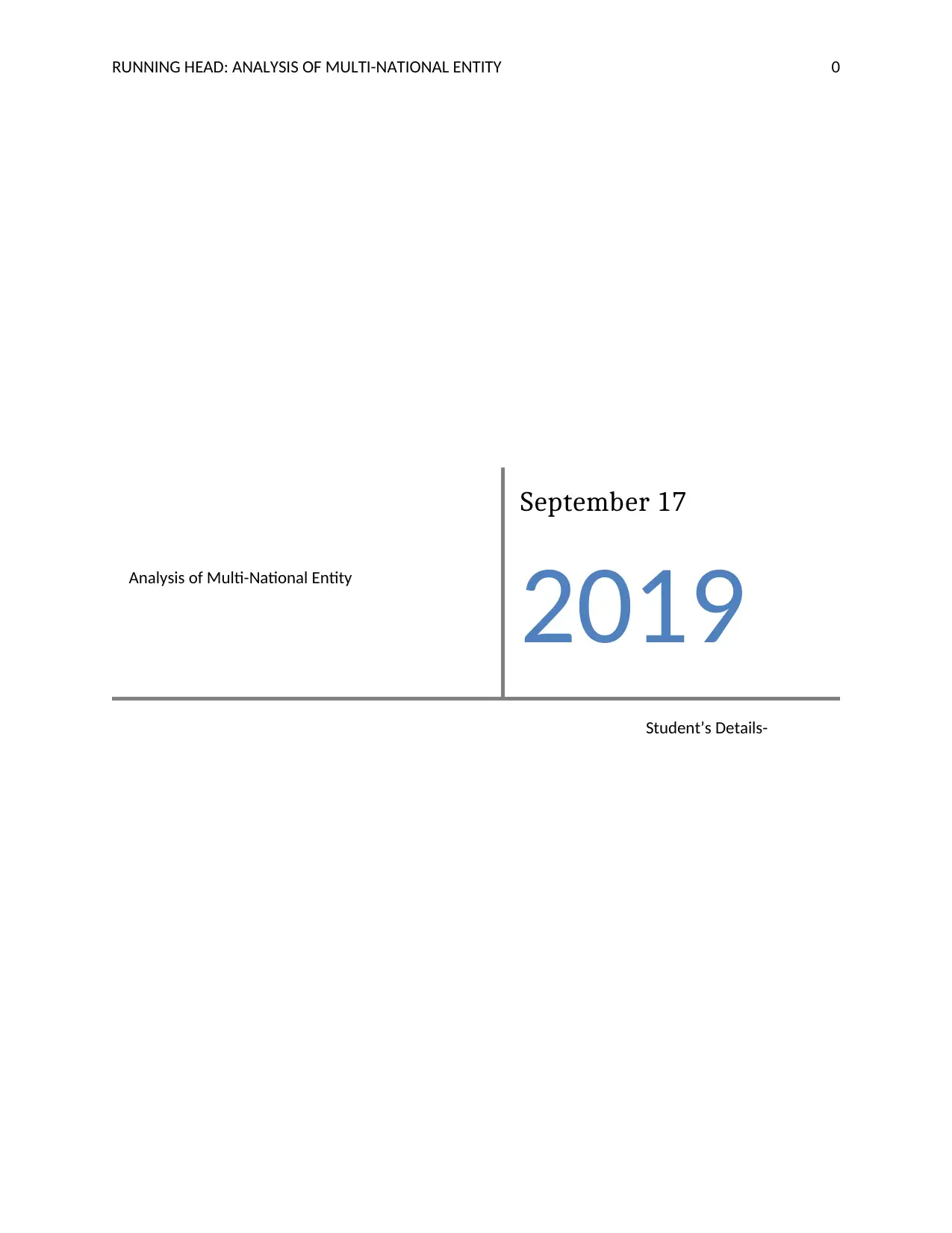
RUNNING HEAD: ANALYSIS OF MULTI-NATIONAL ENTITY 0
Analysis of Multi-National Entity
September 17
2019
Student’s Details-
Analysis of Multi-National Entity
September 17
2019
Student’s Details-
Paraphrase This Document
Need a fresh take? Get an instant paraphrase of this document with our AI Paraphraser
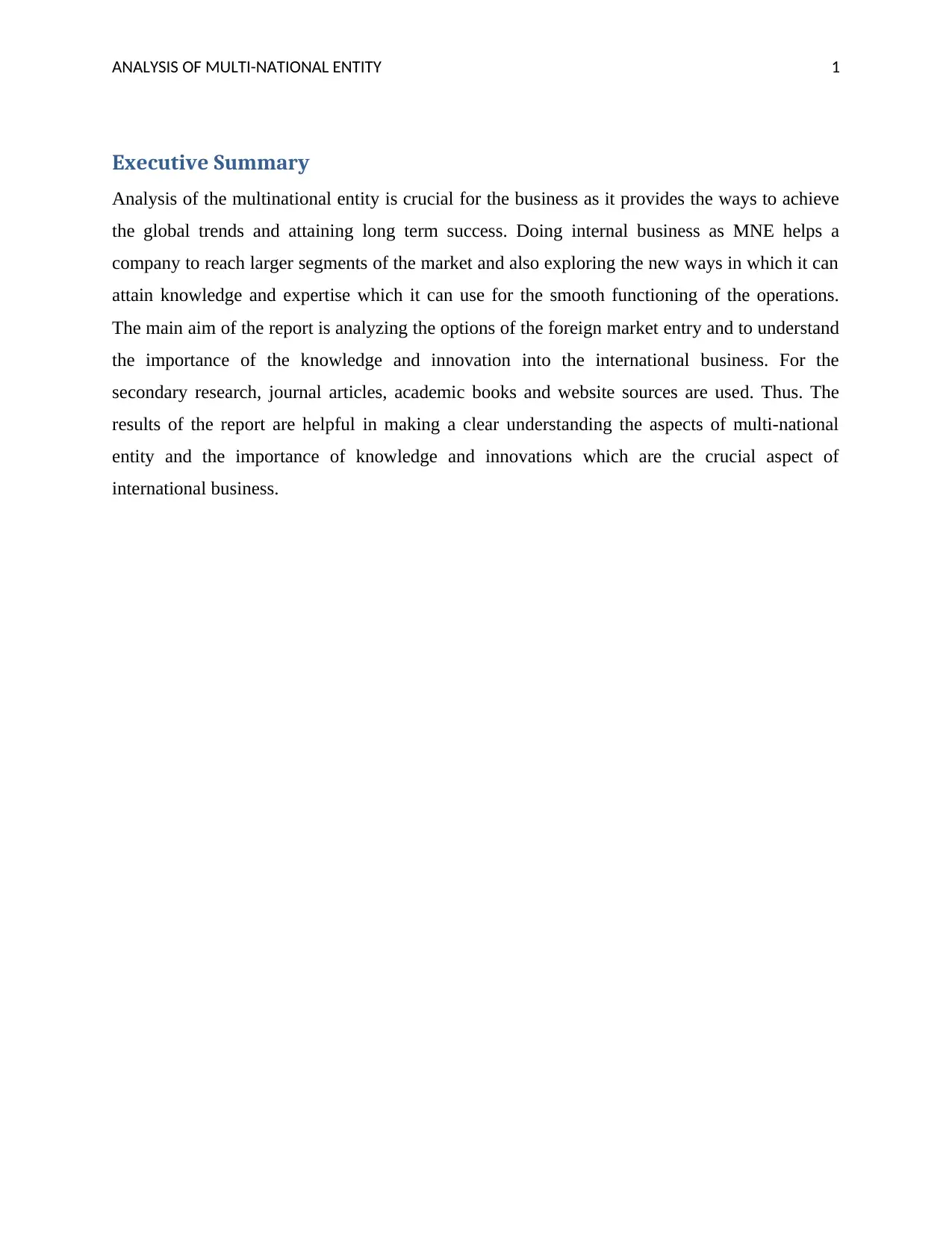
ANALYSIS OF MULTI-NATIONAL ENTITY 1
Executive Summary
Analysis of the multinational entity is crucial for the business as it provides the ways to achieve
the global trends and attaining long term success. Doing internal business as MNE helps a
company to reach larger segments of the market and also exploring the new ways in which it can
attain knowledge and expertise which it can use for the smooth functioning of the operations.
The main aim of the report is analyzing the options of the foreign market entry and to understand
the importance of the knowledge and innovation into the international business. For the
secondary research, journal articles, academic books and website sources are used. Thus. The
results of the report are helpful in making a clear understanding the aspects of multi-national
entity and the importance of knowledge and innovations which are the crucial aspect of
international business.
Executive Summary
Analysis of the multinational entity is crucial for the business as it provides the ways to achieve
the global trends and attaining long term success. Doing internal business as MNE helps a
company to reach larger segments of the market and also exploring the new ways in which it can
attain knowledge and expertise which it can use for the smooth functioning of the operations.
The main aim of the report is analyzing the options of the foreign market entry and to understand
the importance of the knowledge and innovation into the international business. For the
secondary research, journal articles, academic books and website sources are used. Thus. The
results of the report are helpful in making a clear understanding the aspects of multi-national
entity and the importance of knowledge and innovations which are the crucial aspect of
international business.
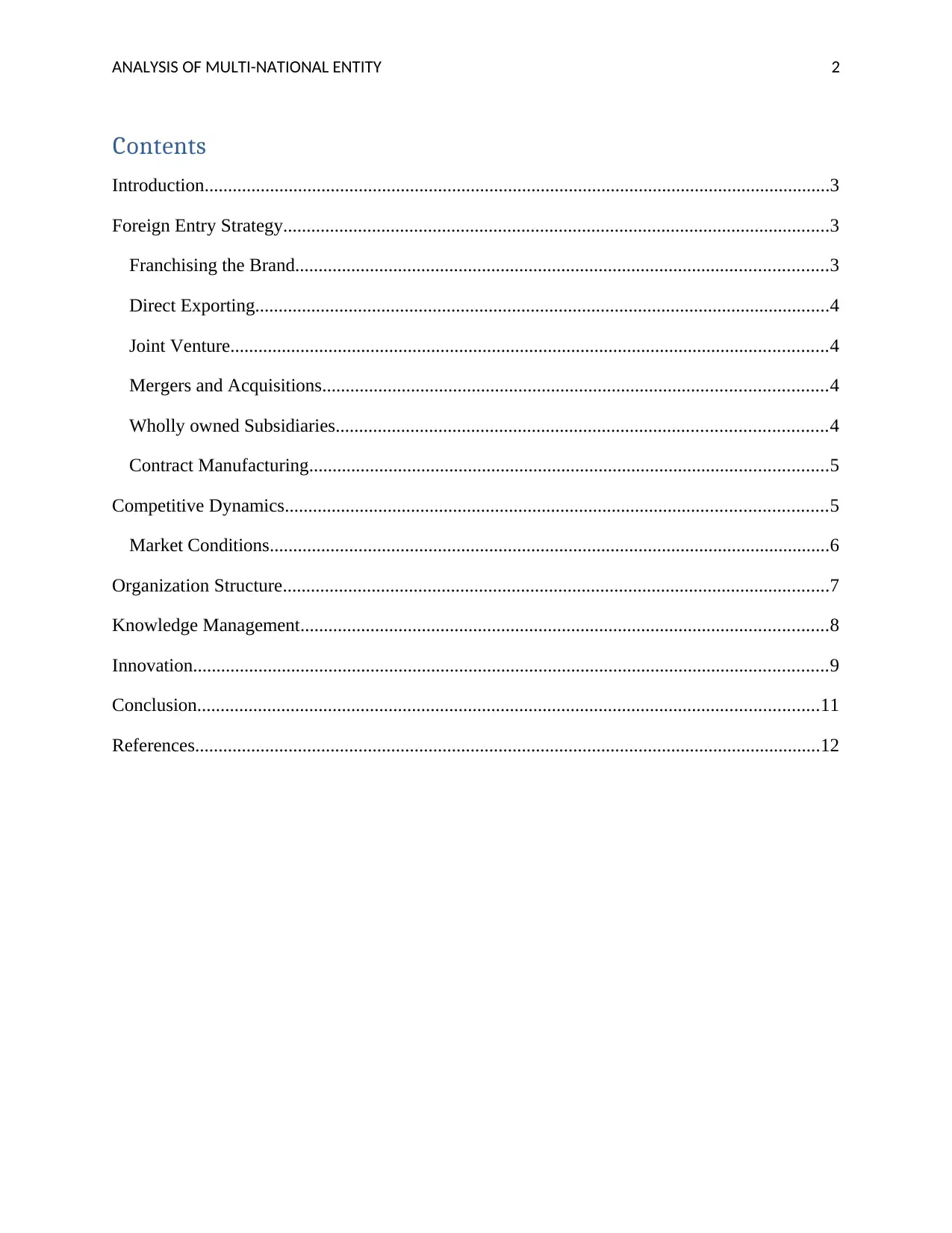
ANALYSIS OF MULTI-NATIONAL ENTITY 2
Contents
Introduction......................................................................................................................................3
Foreign Entry Strategy.....................................................................................................................3
Franchising the Brand..................................................................................................................3
Direct Exporting...........................................................................................................................4
Joint Venture................................................................................................................................4
Mergers and Acquisitions............................................................................................................4
Wholly owned Subsidiaries.........................................................................................................4
Contract Manufacturing...............................................................................................................5
Competitive Dynamics....................................................................................................................5
Market Conditions........................................................................................................................6
Organization Structure.....................................................................................................................7
Knowledge Management.................................................................................................................8
Innovation........................................................................................................................................9
Conclusion.....................................................................................................................................11
References......................................................................................................................................12
Contents
Introduction......................................................................................................................................3
Foreign Entry Strategy.....................................................................................................................3
Franchising the Brand..................................................................................................................3
Direct Exporting...........................................................................................................................4
Joint Venture................................................................................................................................4
Mergers and Acquisitions............................................................................................................4
Wholly owned Subsidiaries.........................................................................................................4
Contract Manufacturing...............................................................................................................5
Competitive Dynamics....................................................................................................................5
Market Conditions........................................................................................................................6
Organization Structure.....................................................................................................................7
Knowledge Management.................................................................................................................8
Innovation........................................................................................................................................9
Conclusion.....................................................................................................................................11
References......................................................................................................................................12
⊘ This is a preview!⊘
Do you want full access?
Subscribe today to unlock all pages.

Trusted by 1+ million students worldwide
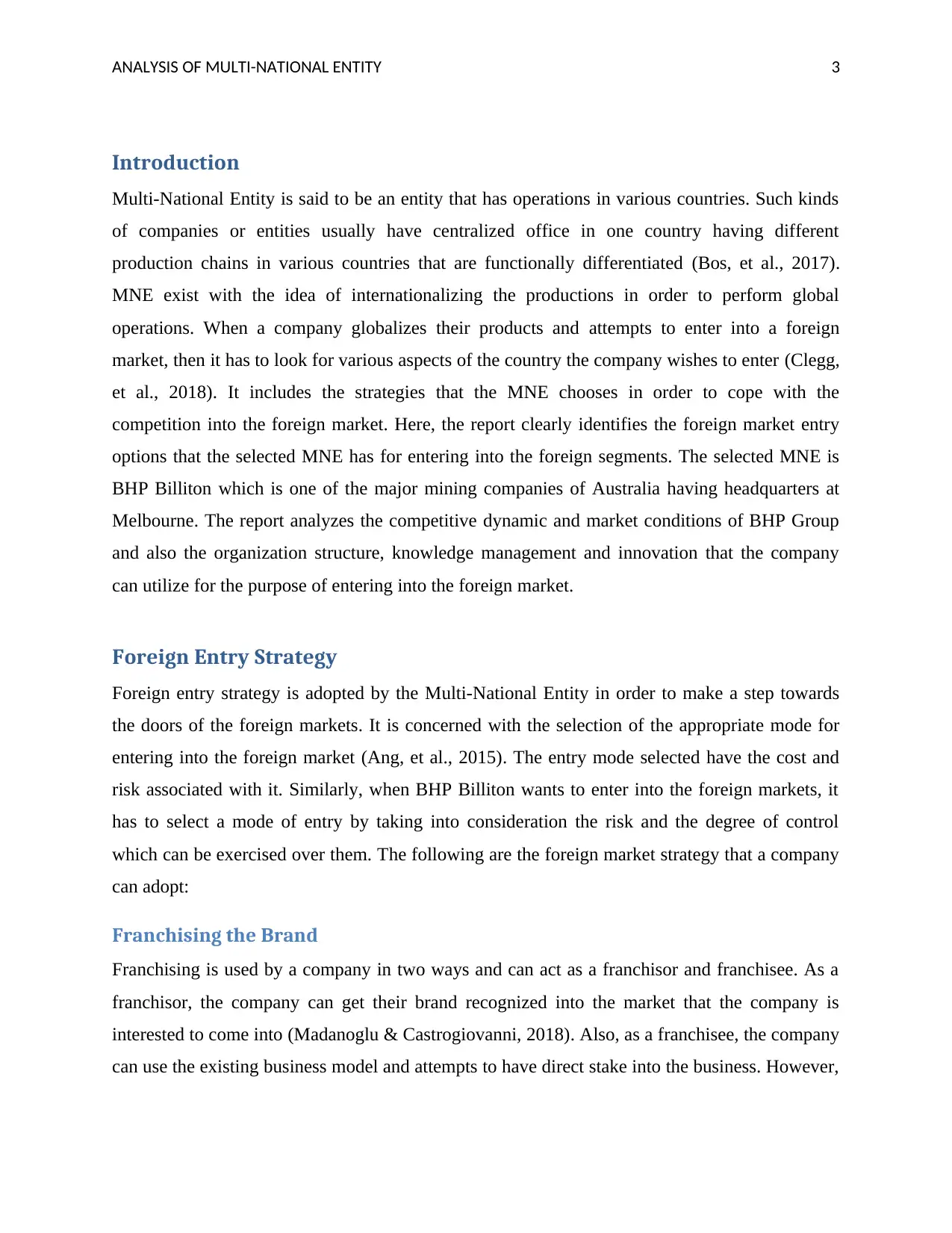
ANALYSIS OF MULTI-NATIONAL ENTITY 3
Introduction
Multi-National Entity is said to be an entity that has operations in various countries. Such kinds
of companies or entities usually have centralized office in one country having different
production chains in various countries that are functionally differentiated (Bos, et al., 2017).
MNE exist with the idea of internationalizing the productions in order to perform global
operations. When a company globalizes their products and attempts to enter into a foreign
market, then it has to look for various aspects of the country the company wishes to enter (Clegg,
et al., 2018). It includes the strategies that the MNE chooses in order to cope with the
competition into the foreign market. Here, the report clearly identifies the foreign market entry
options that the selected MNE has for entering into the foreign segments. The selected MNE is
BHP Billiton which is one of the major mining companies of Australia having headquarters at
Melbourne. The report analyzes the competitive dynamic and market conditions of BHP Group
and also the organization structure, knowledge management and innovation that the company
can utilize for the purpose of entering into the foreign market.
Foreign Entry Strategy
Foreign entry strategy is adopted by the Multi-National Entity in order to make a step towards
the doors of the foreign markets. It is concerned with the selection of the appropriate mode for
entering into the foreign market (Ang, et al., 2015). The entry mode selected have the cost and
risk associated with it. Similarly, when BHP Billiton wants to enter into the foreign markets, it
has to select a mode of entry by taking into consideration the risk and the degree of control
which can be exercised over them. The following are the foreign market strategy that a company
can adopt:
Franchising the Brand
Franchising is used by a company in two ways and can act as a franchisor and franchisee. As a
franchisor, the company can get their brand recognized into the market that the company is
interested to come into (Madanoglu & Castrogiovanni, 2018). Also, as a franchisee, the company
can use the existing business model and attempts to have direct stake into the business. However,
Introduction
Multi-National Entity is said to be an entity that has operations in various countries. Such kinds
of companies or entities usually have centralized office in one country having different
production chains in various countries that are functionally differentiated (Bos, et al., 2017).
MNE exist with the idea of internationalizing the productions in order to perform global
operations. When a company globalizes their products and attempts to enter into a foreign
market, then it has to look for various aspects of the country the company wishes to enter (Clegg,
et al., 2018). It includes the strategies that the MNE chooses in order to cope with the
competition into the foreign market. Here, the report clearly identifies the foreign market entry
options that the selected MNE has for entering into the foreign segments. The selected MNE is
BHP Billiton which is one of the major mining companies of Australia having headquarters at
Melbourne. The report analyzes the competitive dynamic and market conditions of BHP Group
and also the organization structure, knowledge management and innovation that the company
can utilize for the purpose of entering into the foreign market.
Foreign Entry Strategy
Foreign entry strategy is adopted by the Multi-National Entity in order to make a step towards
the doors of the foreign markets. It is concerned with the selection of the appropriate mode for
entering into the foreign market (Ang, et al., 2015). The entry mode selected have the cost and
risk associated with it. Similarly, when BHP Billiton wants to enter into the foreign markets, it
has to select a mode of entry by taking into consideration the risk and the degree of control
which can be exercised over them. The following are the foreign market strategy that a company
can adopt:
Franchising the Brand
Franchising is used by a company in two ways and can act as a franchisor and franchisee. As a
franchisor, the company can get their brand recognized into the market that the company is
interested to come into (Madanoglu & Castrogiovanni, 2018). Also, as a franchisee, the company
can use the existing business model and attempts to have direct stake into the business. However,
Paraphrase This Document
Need a fresh take? Get an instant paraphrase of this document with our AI Paraphraser
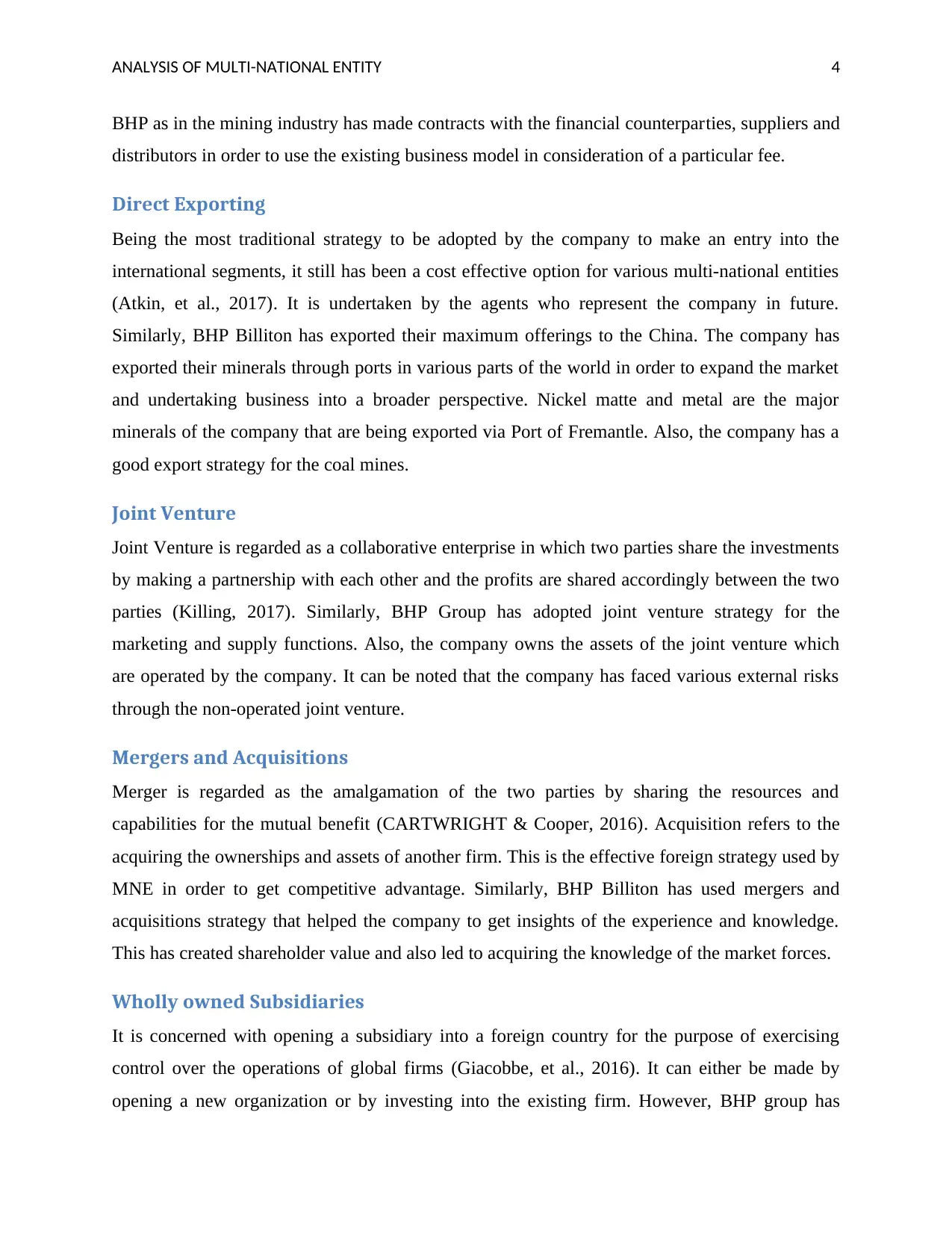
ANALYSIS OF MULTI-NATIONAL ENTITY 4
BHP as in the mining industry has made contracts with the financial counterparties, suppliers and
distributors in order to use the existing business model in consideration of a particular fee.
Direct Exporting
Being the most traditional strategy to be adopted by the company to make an entry into the
international segments, it still has been a cost effective option for various multi-national entities
(Atkin, et al., 2017). It is undertaken by the agents who represent the company in future.
Similarly, BHP Billiton has exported their maximum offerings to the China. The company has
exported their minerals through ports in various parts of the world in order to expand the market
and undertaking business into a broader perspective. Nickel matte and metal are the major
minerals of the company that are being exported via Port of Fremantle. Also, the company has a
good export strategy for the coal mines.
Joint Venture
Joint Venture is regarded as a collaborative enterprise in which two parties share the investments
by making a partnership with each other and the profits are shared accordingly between the two
parties (Killing, 2017). Similarly, BHP Group has adopted joint venture strategy for the
marketing and supply functions. Also, the company owns the assets of the joint venture which
are operated by the company. It can be noted that the company has faced various external risks
through the non-operated joint venture.
Mergers and Acquisitions
Merger is regarded as the amalgamation of the two parties by sharing the resources and
capabilities for the mutual benefit (CARTWRIGHT & Cooper, 2016). Acquisition refers to the
acquiring the ownerships and assets of another firm. This is the effective foreign strategy used by
MNE in order to get competitive advantage. Similarly, BHP Billiton has used mergers and
acquisitions strategy that helped the company to get insights of the experience and knowledge.
This has created shareholder value and also led to acquiring the knowledge of the market forces.
Wholly owned Subsidiaries
It is concerned with opening a subsidiary into a foreign country for the purpose of exercising
control over the operations of global firms (Giacobbe, et al., 2016). It can either be made by
opening a new organization or by investing into the existing firm. However, BHP group has
BHP as in the mining industry has made contracts with the financial counterparties, suppliers and
distributors in order to use the existing business model in consideration of a particular fee.
Direct Exporting
Being the most traditional strategy to be adopted by the company to make an entry into the
international segments, it still has been a cost effective option for various multi-national entities
(Atkin, et al., 2017). It is undertaken by the agents who represent the company in future.
Similarly, BHP Billiton has exported their maximum offerings to the China. The company has
exported their minerals through ports in various parts of the world in order to expand the market
and undertaking business into a broader perspective. Nickel matte and metal are the major
minerals of the company that are being exported via Port of Fremantle. Also, the company has a
good export strategy for the coal mines.
Joint Venture
Joint Venture is regarded as a collaborative enterprise in which two parties share the investments
by making a partnership with each other and the profits are shared accordingly between the two
parties (Killing, 2017). Similarly, BHP Group has adopted joint venture strategy for the
marketing and supply functions. Also, the company owns the assets of the joint venture which
are operated by the company. It can be noted that the company has faced various external risks
through the non-operated joint venture.
Mergers and Acquisitions
Merger is regarded as the amalgamation of the two parties by sharing the resources and
capabilities for the mutual benefit (CARTWRIGHT & Cooper, 2016). Acquisition refers to the
acquiring the ownerships and assets of another firm. This is the effective foreign strategy used by
MNE in order to get competitive advantage. Similarly, BHP Billiton has used mergers and
acquisitions strategy that helped the company to get insights of the experience and knowledge.
This has created shareholder value and also led to acquiring the knowledge of the market forces.
Wholly owned Subsidiaries
It is concerned with opening a subsidiary into a foreign country for the purpose of exercising
control over the operations of global firms (Giacobbe, et al., 2016). It can either be made by
opening a new organization or by investing into the existing firm. However, BHP group has
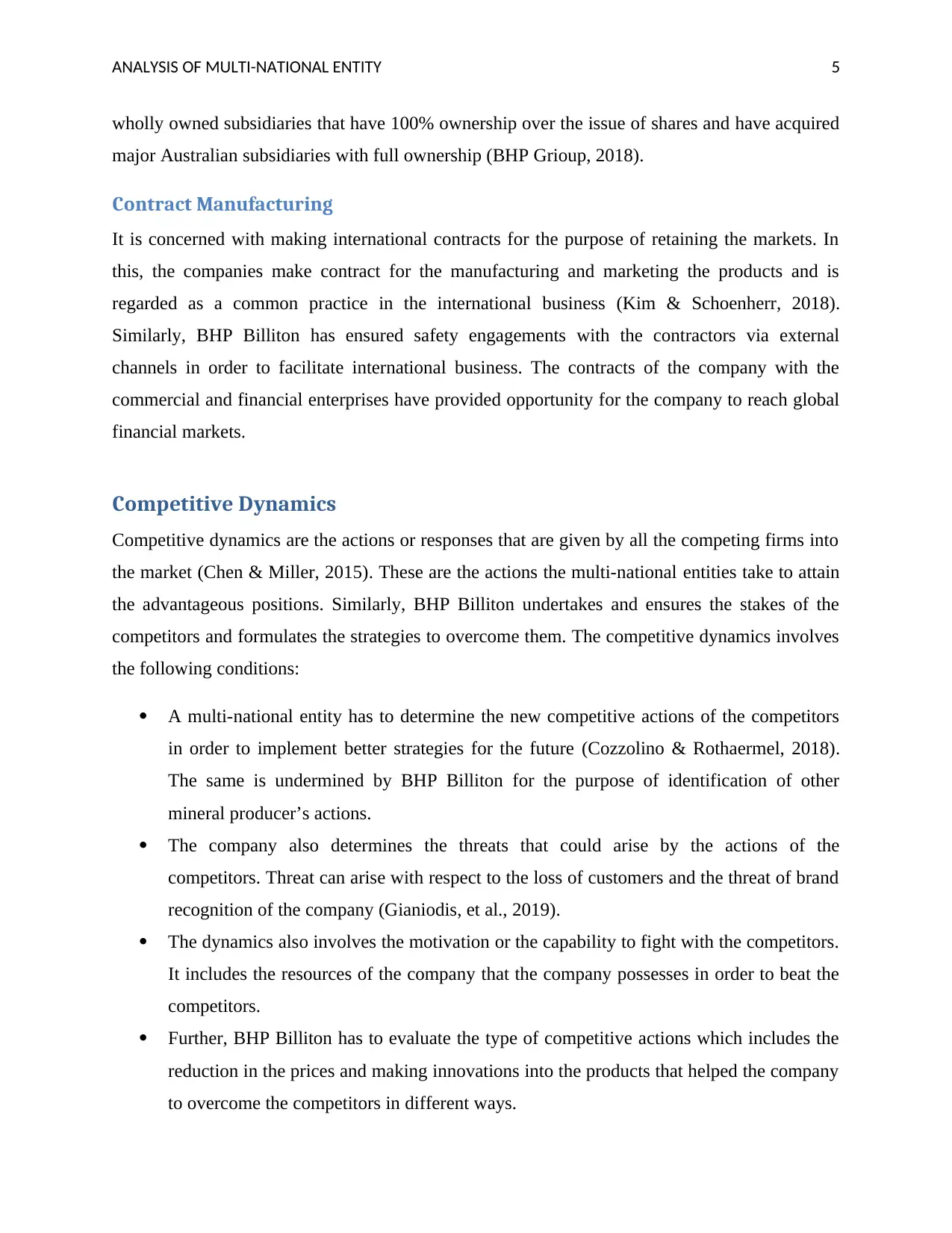
ANALYSIS OF MULTI-NATIONAL ENTITY 5
wholly owned subsidiaries that have 100% ownership over the issue of shares and have acquired
major Australian subsidiaries with full ownership (BHP Grioup, 2018).
Contract Manufacturing
It is concerned with making international contracts for the purpose of retaining the markets. In
this, the companies make contract for the manufacturing and marketing the products and is
regarded as a common practice in the international business (Kim & Schoenherr, 2018).
Similarly, BHP Billiton has ensured safety engagements with the contractors via external
channels in order to facilitate international business. The contracts of the company with the
commercial and financial enterprises have provided opportunity for the company to reach global
financial markets.
Competitive Dynamics
Competitive dynamics are the actions or responses that are given by all the competing firms into
the market (Chen & Miller, 2015). These are the actions the multi-national entities take to attain
the advantageous positions. Similarly, BHP Billiton undertakes and ensures the stakes of the
competitors and formulates the strategies to overcome them. The competitive dynamics involves
the following conditions:
A multi-national entity has to determine the new competitive actions of the competitors
in order to implement better strategies for the future (Cozzolino & Rothaermel, 2018).
The same is undermined by BHP Billiton for the purpose of identification of other
mineral producer’s actions.
The company also determines the threats that could arise by the actions of the
competitors. Threat can arise with respect to the loss of customers and the threat of brand
recognition of the company (Gianiodis, et al., 2019).
The dynamics also involves the motivation or the capability to fight with the competitors.
It includes the resources of the company that the company possesses in order to beat the
competitors.
Further, BHP Billiton has to evaluate the type of competitive actions which includes the
reduction in the prices and making innovations into the products that helped the company
to overcome the competitors in different ways.
wholly owned subsidiaries that have 100% ownership over the issue of shares and have acquired
major Australian subsidiaries with full ownership (BHP Grioup, 2018).
Contract Manufacturing
It is concerned with making international contracts for the purpose of retaining the markets. In
this, the companies make contract for the manufacturing and marketing the products and is
regarded as a common practice in the international business (Kim & Schoenherr, 2018).
Similarly, BHP Billiton has ensured safety engagements with the contractors via external
channels in order to facilitate international business. The contracts of the company with the
commercial and financial enterprises have provided opportunity for the company to reach global
financial markets.
Competitive Dynamics
Competitive dynamics are the actions or responses that are given by all the competing firms into
the market (Chen & Miller, 2015). These are the actions the multi-national entities take to attain
the advantageous positions. Similarly, BHP Billiton undertakes and ensures the stakes of the
competitors and formulates the strategies to overcome them. The competitive dynamics involves
the following conditions:
A multi-national entity has to determine the new competitive actions of the competitors
in order to implement better strategies for the future (Cozzolino & Rothaermel, 2018).
The same is undermined by BHP Billiton for the purpose of identification of other
mineral producer’s actions.
The company also determines the threats that could arise by the actions of the
competitors. Threat can arise with respect to the loss of customers and the threat of brand
recognition of the company (Gianiodis, et al., 2019).
The dynamics also involves the motivation or the capability to fight with the competitors.
It includes the resources of the company that the company possesses in order to beat the
competitors.
Further, BHP Billiton has to evaluate the type of competitive actions which includes the
reduction in the prices and making innovations into the products that helped the company
to overcome the competitors in different ways.
⊘ This is a preview!⊘
Do you want full access?
Subscribe today to unlock all pages.

Trusted by 1+ million students worldwide
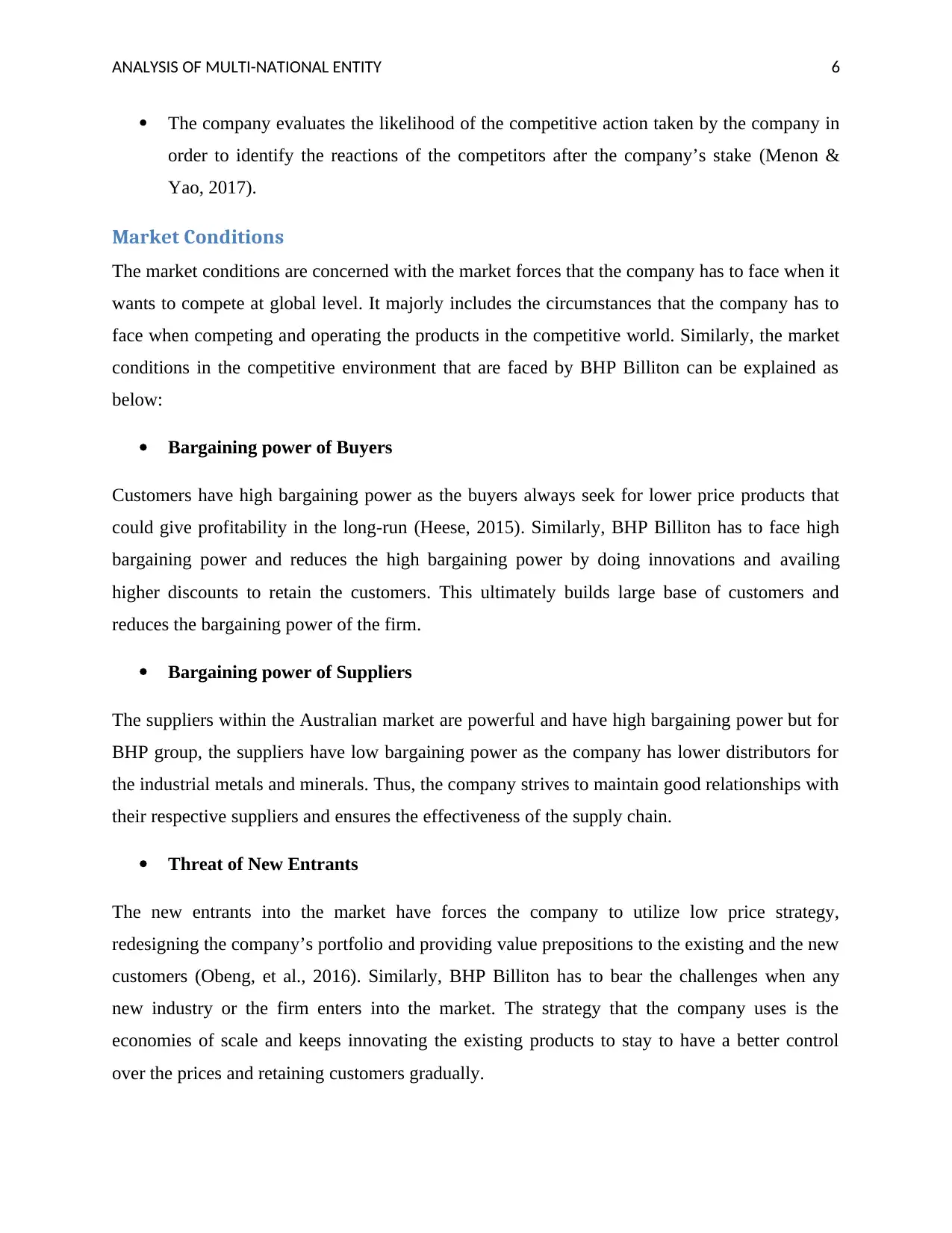
ANALYSIS OF MULTI-NATIONAL ENTITY 6
The company evaluates the likelihood of the competitive action taken by the company in
order to identify the reactions of the competitors after the company’s stake (Menon &
Yao, 2017).
Market Conditions
The market conditions are concerned with the market forces that the company has to face when it
wants to compete at global level. It majorly includes the circumstances that the company has to
face when competing and operating the products in the competitive world. Similarly, the market
conditions in the competitive environment that are faced by BHP Billiton can be explained as
below:
Bargaining power of Buyers
Customers have high bargaining power as the buyers always seek for lower price products that
could give profitability in the long-run (Heese, 2015). Similarly, BHP Billiton has to face high
bargaining power and reduces the high bargaining power by doing innovations and availing
higher discounts to retain the customers. This ultimately builds large base of customers and
reduces the bargaining power of the firm.
Bargaining power of Suppliers
The suppliers within the Australian market are powerful and have high bargaining power but for
BHP group, the suppliers have low bargaining power as the company has lower distributors for
the industrial metals and minerals. Thus, the company strives to maintain good relationships with
their respective suppliers and ensures the effectiveness of the supply chain.
Threat of New Entrants
The new entrants into the market have forces the company to utilize low price strategy,
redesigning the company’s portfolio and providing value prepositions to the existing and the new
customers (Obeng, et al., 2016). Similarly, BHP Billiton has to bear the challenges when any
new industry or the firm enters into the market. The strategy that the company uses is the
economies of scale and keeps innovating the existing products to stay to have a better control
over the prices and retaining customers gradually.
The company evaluates the likelihood of the competitive action taken by the company in
order to identify the reactions of the competitors after the company’s stake (Menon &
Yao, 2017).
Market Conditions
The market conditions are concerned with the market forces that the company has to face when it
wants to compete at global level. It majorly includes the circumstances that the company has to
face when competing and operating the products in the competitive world. Similarly, the market
conditions in the competitive environment that are faced by BHP Billiton can be explained as
below:
Bargaining power of Buyers
Customers have high bargaining power as the buyers always seek for lower price products that
could give profitability in the long-run (Heese, 2015). Similarly, BHP Billiton has to face high
bargaining power and reduces the high bargaining power by doing innovations and availing
higher discounts to retain the customers. This ultimately builds large base of customers and
reduces the bargaining power of the firm.
Bargaining power of Suppliers
The suppliers within the Australian market are powerful and have high bargaining power but for
BHP group, the suppliers have low bargaining power as the company has lower distributors for
the industrial metals and minerals. Thus, the company strives to maintain good relationships with
their respective suppliers and ensures the effectiveness of the supply chain.
Threat of New Entrants
The new entrants into the market have forces the company to utilize low price strategy,
redesigning the company’s portfolio and providing value prepositions to the existing and the new
customers (Obeng, et al., 2016). Similarly, BHP Billiton has to bear the challenges when any
new industry or the firm enters into the market. The strategy that the company uses is the
economies of scale and keeps innovating the existing products to stay to have a better control
over the prices and retaining customers gradually.
Paraphrase This Document
Need a fresh take? Get an instant paraphrase of this document with our AI Paraphraser
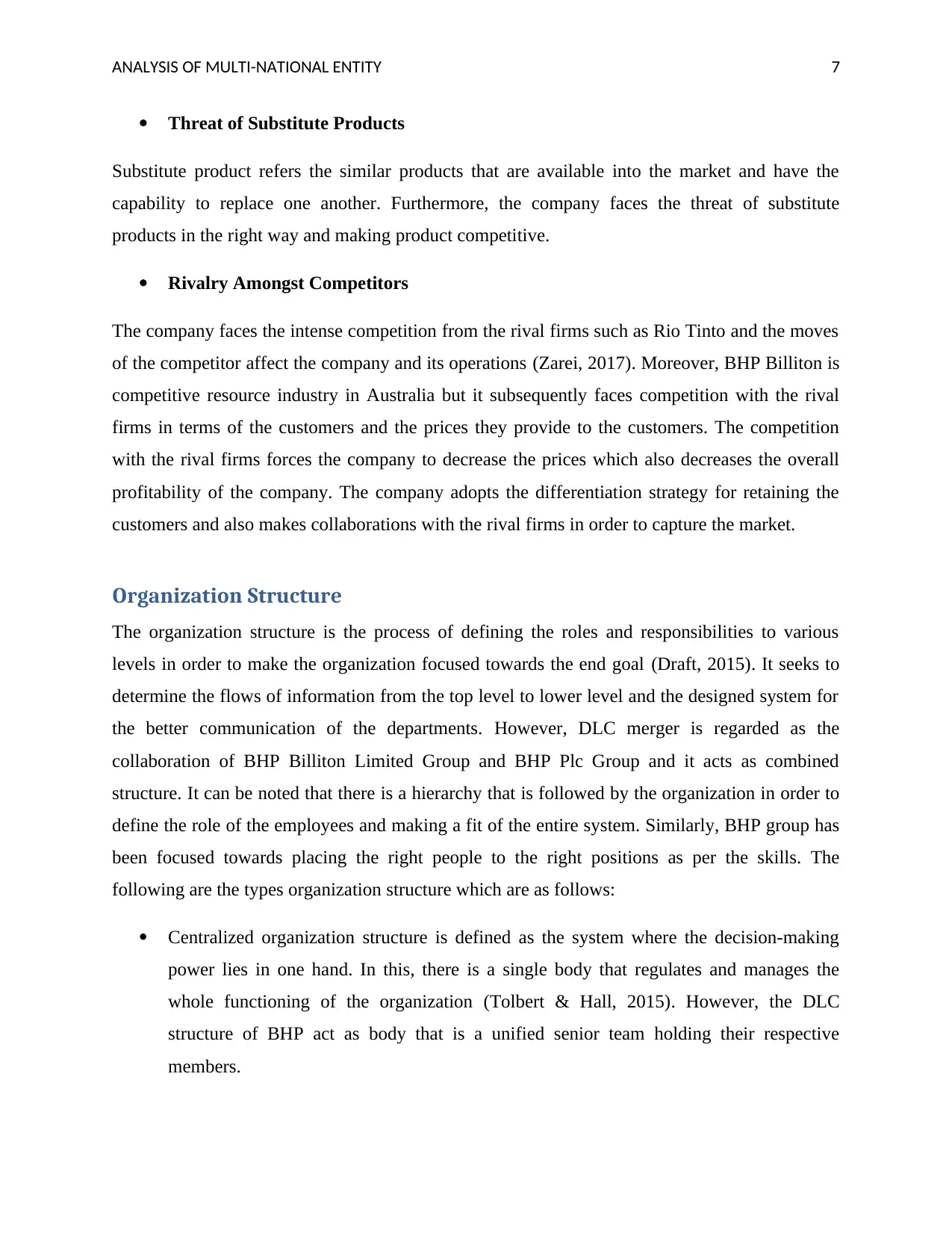
ANALYSIS OF MULTI-NATIONAL ENTITY 7
Threat of Substitute Products
Substitute product refers the similar products that are available into the market and have the
capability to replace one another. Furthermore, the company faces the threat of substitute
products in the right way and making product competitive.
Rivalry Amongst Competitors
The company faces the intense competition from the rival firms such as Rio Tinto and the moves
of the competitor affect the company and its operations (Zarei, 2017). Moreover, BHP Billiton is
competitive resource industry in Australia but it subsequently faces competition with the rival
firms in terms of the customers and the prices they provide to the customers. The competition
with the rival firms forces the company to decrease the prices which also decreases the overall
profitability of the company. The company adopts the differentiation strategy for retaining the
customers and also makes collaborations with the rival firms in order to capture the market.
Organization Structure
The organization structure is the process of defining the roles and responsibilities to various
levels in order to make the organization focused towards the end goal (Draft, 2015). It seeks to
determine the flows of information from the top level to lower level and the designed system for
the better communication of the departments. However, DLC merger is regarded as the
collaboration of BHP Billiton Limited Group and BHP Plc Group and it acts as combined
structure. It can be noted that there is a hierarchy that is followed by the organization in order to
define the role of the employees and making a fit of the entire system. Similarly, BHP group has
been focused towards placing the right people to the right positions as per the skills. The
following are the types organization structure which are as follows:
Centralized organization structure is defined as the system where the decision-making
power lies in one hand. In this, there is a single body that regulates and manages the
whole functioning of the organization (Tolbert & Hall, 2015). However, the DLC
structure of BHP act as body that is a unified senior team holding their respective
members.
Threat of Substitute Products
Substitute product refers the similar products that are available into the market and have the
capability to replace one another. Furthermore, the company faces the threat of substitute
products in the right way and making product competitive.
Rivalry Amongst Competitors
The company faces the intense competition from the rival firms such as Rio Tinto and the moves
of the competitor affect the company and its operations (Zarei, 2017). Moreover, BHP Billiton is
competitive resource industry in Australia but it subsequently faces competition with the rival
firms in terms of the customers and the prices they provide to the customers. The competition
with the rival firms forces the company to decrease the prices which also decreases the overall
profitability of the company. The company adopts the differentiation strategy for retaining the
customers and also makes collaborations with the rival firms in order to capture the market.
Organization Structure
The organization structure is the process of defining the roles and responsibilities to various
levels in order to make the organization focused towards the end goal (Draft, 2015). It seeks to
determine the flows of information from the top level to lower level and the designed system for
the better communication of the departments. However, DLC merger is regarded as the
collaboration of BHP Billiton Limited Group and BHP Plc Group and it acts as combined
structure. It can be noted that there is a hierarchy that is followed by the organization in order to
define the role of the employees and making a fit of the entire system. Similarly, BHP group has
been focused towards placing the right people to the right positions as per the skills. The
following are the types organization structure which are as follows:
Centralized organization structure is defined as the system where the decision-making
power lies in one hand. In this, there is a single body that regulates and manages the
whole functioning of the organization (Tolbert & Hall, 2015). However, the DLC
structure of BHP act as body that is a unified senior team holding their respective
members.
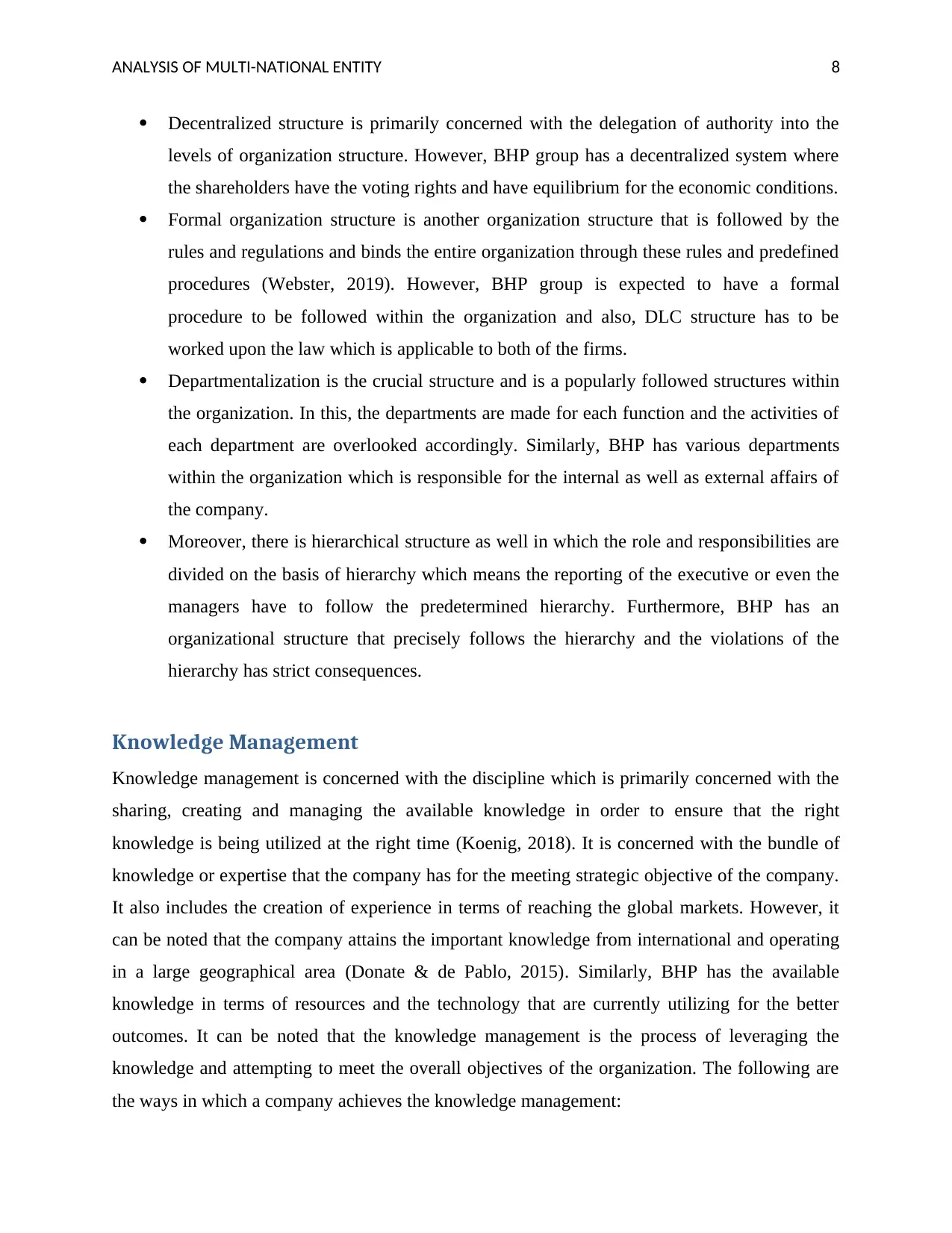
ANALYSIS OF MULTI-NATIONAL ENTITY 8
Decentralized structure is primarily concerned with the delegation of authority into the
levels of organization structure. However, BHP group has a decentralized system where
the shareholders have the voting rights and have equilibrium for the economic conditions.
Formal organization structure is another organization structure that is followed by the
rules and regulations and binds the entire organization through these rules and predefined
procedures (Webster, 2019). However, BHP group is expected to have a formal
procedure to be followed within the organization and also, DLC structure has to be
worked upon the law which is applicable to both of the firms.
Departmentalization is the crucial structure and is a popularly followed structures within
the organization. In this, the departments are made for each function and the activities of
each department are overlooked accordingly. Similarly, BHP has various departments
within the organization which is responsible for the internal as well as external affairs of
the company.
Moreover, there is hierarchical structure as well in which the role and responsibilities are
divided on the basis of hierarchy which means the reporting of the executive or even the
managers have to follow the predetermined hierarchy. Furthermore, BHP has an
organizational structure that precisely follows the hierarchy and the violations of the
hierarchy has strict consequences.
Knowledge Management
Knowledge management is concerned with the discipline which is primarily concerned with the
sharing, creating and managing the available knowledge in order to ensure that the right
knowledge is being utilized at the right time (Koenig, 2018). It is concerned with the bundle of
knowledge or expertise that the company has for the meeting strategic objective of the company.
It also includes the creation of experience in terms of reaching the global markets. However, it
can be noted that the company attains the important knowledge from international and operating
in a large geographical area (Donate & de Pablo, 2015). Similarly, BHP has the available
knowledge in terms of resources and the technology that are currently utilizing for the better
outcomes. It can be noted that the knowledge management is the process of leveraging the
knowledge and attempting to meet the overall objectives of the organization. The following are
the ways in which a company achieves the knowledge management:
Decentralized structure is primarily concerned with the delegation of authority into the
levels of organization structure. However, BHP group has a decentralized system where
the shareholders have the voting rights and have equilibrium for the economic conditions.
Formal organization structure is another organization structure that is followed by the
rules and regulations and binds the entire organization through these rules and predefined
procedures (Webster, 2019). However, BHP group is expected to have a formal
procedure to be followed within the organization and also, DLC structure has to be
worked upon the law which is applicable to both of the firms.
Departmentalization is the crucial structure and is a popularly followed structures within
the organization. In this, the departments are made for each function and the activities of
each department are overlooked accordingly. Similarly, BHP has various departments
within the organization which is responsible for the internal as well as external affairs of
the company.
Moreover, there is hierarchical structure as well in which the role and responsibilities are
divided on the basis of hierarchy which means the reporting of the executive or even the
managers have to follow the predetermined hierarchy. Furthermore, BHP has an
organizational structure that precisely follows the hierarchy and the violations of the
hierarchy has strict consequences.
Knowledge Management
Knowledge management is concerned with the discipline which is primarily concerned with the
sharing, creating and managing the available knowledge in order to ensure that the right
knowledge is being utilized at the right time (Koenig, 2018). It is concerned with the bundle of
knowledge or expertise that the company has for the meeting strategic objective of the company.
It also includes the creation of experience in terms of reaching the global markets. However, it
can be noted that the company attains the important knowledge from international and operating
in a large geographical area (Donate & de Pablo, 2015). Similarly, BHP has the available
knowledge in terms of resources and the technology that are currently utilizing for the better
outcomes. It can be noted that the knowledge management is the process of leveraging the
knowledge and attempting to meet the overall objectives of the organization. The following are
the ways in which a company achieves the knowledge management:
⊘ This is a preview!⊘
Do you want full access?
Subscribe today to unlock all pages.

Trusted by 1+ million students worldwide
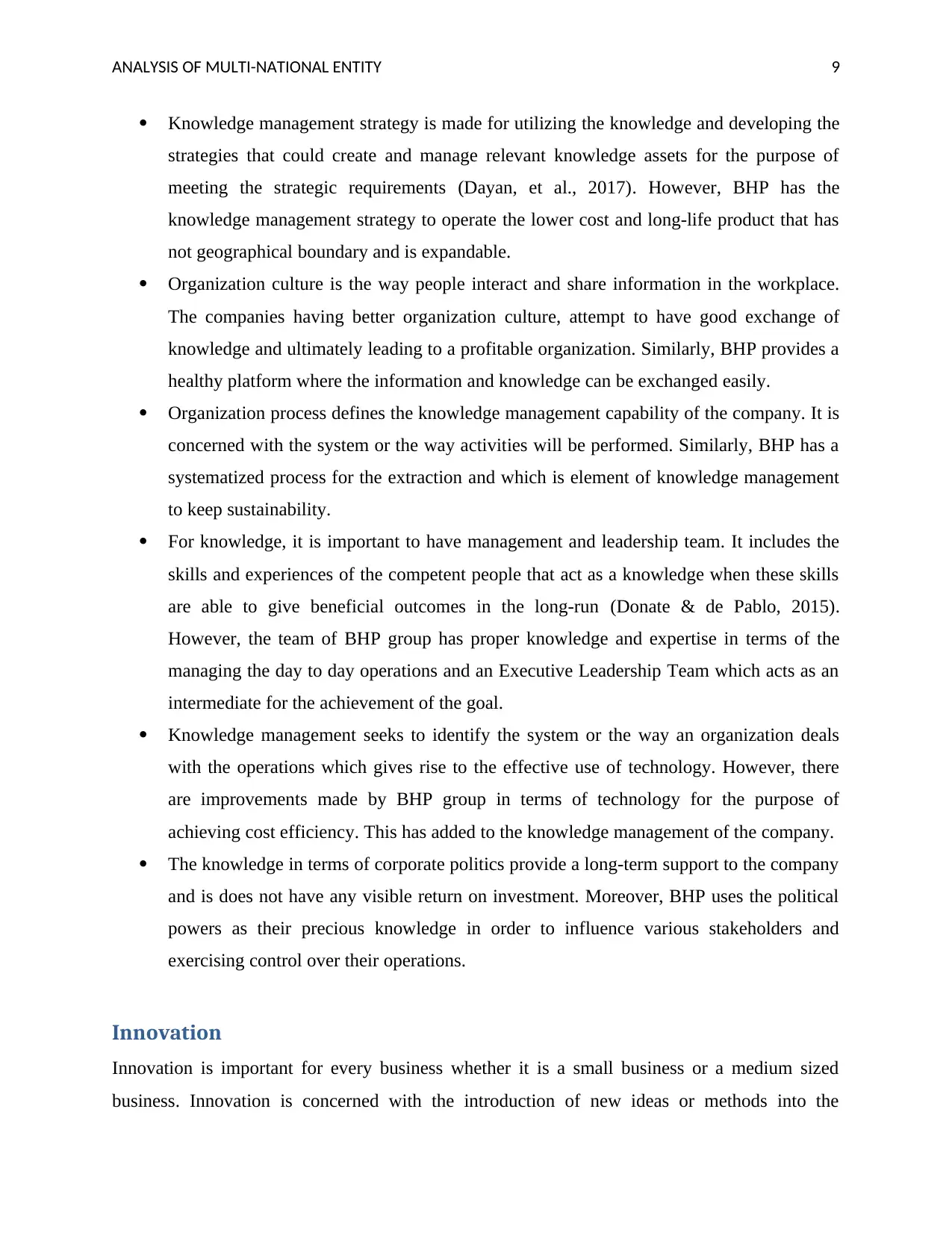
ANALYSIS OF MULTI-NATIONAL ENTITY 9
Knowledge management strategy is made for utilizing the knowledge and developing the
strategies that could create and manage relevant knowledge assets for the purpose of
meeting the strategic requirements (Dayan, et al., 2017). However, BHP has the
knowledge management strategy to operate the lower cost and long-life product that has
not geographical boundary and is expandable.
Organization culture is the way people interact and share information in the workplace.
The companies having better organization culture, attempt to have good exchange of
knowledge and ultimately leading to a profitable organization. Similarly, BHP provides a
healthy platform where the information and knowledge can be exchanged easily.
Organization process defines the knowledge management capability of the company. It is
concerned with the system or the way activities will be performed. Similarly, BHP has a
systematized process for the extraction and which is element of knowledge management
to keep sustainability.
For knowledge, it is important to have management and leadership team. It includes the
skills and experiences of the competent people that act as a knowledge when these skills
are able to give beneficial outcomes in the long-run (Donate & de Pablo, 2015).
However, the team of BHP group has proper knowledge and expertise in terms of the
managing the day to day operations and an Executive Leadership Team which acts as an
intermediate for the achievement of the goal.
Knowledge management seeks to identify the system or the way an organization deals
with the operations which gives rise to the effective use of technology. However, there
are improvements made by BHP group in terms of technology for the purpose of
achieving cost efficiency. This has added to the knowledge management of the company.
The knowledge in terms of corporate politics provide a long-term support to the company
and is does not have any visible return on investment. Moreover, BHP uses the political
powers as their precious knowledge in order to influence various stakeholders and
exercising control over their operations.
Innovation
Innovation is important for every business whether it is a small business or a medium sized
business. Innovation is concerned with the introduction of new ideas or methods into the
Knowledge management strategy is made for utilizing the knowledge and developing the
strategies that could create and manage relevant knowledge assets for the purpose of
meeting the strategic requirements (Dayan, et al., 2017). However, BHP has the
knowledge management strategy to operate the lower cost and long-life product that has
not geographical boundary and is expandable.
Organization culture is the way people interact and share information in the workplace.
The companies having better organization culture, attempt to have good exchange of
knowledge and ultimately leading to a profitable organization. Similarly, BHP provides a
healthy platform where the information and knowledge can be exchanged easily.
Organization process defines the knowledge management capability of the company. It is
concerned with the system or the way activities will be performed. Similarly, BHP has a
systematized process for the extraction and which is element of knowledge management
to keep sustainability.
For knowledge, it is important to have management and leadership team. It includes the
skills and experiences of the competent people that act as a knowledge when these skills
are able to give beneficial outcomes in the long-run (Donate & de Pablo, 2015).
However, the team of BHP group has proper knowledge and expertise in terms of the
managing the day to day operations and an Executive Leadership Team which acts as an
intermediate for the achievement of the goal.
Knowledge management seeks to identify the system or the way an organization deals
with the operations which gives rise to the effective use of technology. However, there
are improvements made by BHP group in terms of technology for the purpose of
achieving cost efficiency. This has added to the knowledge management of the company.
The knowledge in terms of corporate politics provide a long-term support to the company
and is does not have any visible return on investment. Moreover, BHP uses the political
powers as their precious knowledge in order to influence various stakeholders and
exercising control over their operations.
Innovation
Innovation is important for every business whether it is a small business or a medium sized
business. Innovation is concerned with the introduction of new ideas or methods into the
Paraphrase This Document
Need a fresh take? Get an instant paraphrase of this document with our AI Paraphraser

ANALYSIS OF MULTI-NATIONAL ENTITY 10
business in order to have better stake into the market (Greenwald, 2014). Innovation is the need
for every business and is directly related with the creativity that a company perceives. Further,
innovation helps a company to attract new customers as the customers want new things every
day. Also, it helps in the overcoming competitors through innovating the products which keeps
the customers binding towards the company. Similarly, BHP Billiton is an international
organization that has made innovations in various areas in order to be ahead of the competition
and meeting the diverse needs of the customers. The company’s innovative ideas are cost
effective and the company has majorly made advancement in technology for developing new
ways of doing business. The following are some of the areas where improvements are made by
the company:
BHP has taken a step towards the biodiversity through innovation. The company has
developed South Flank Mine at Western Australia Iron Ore and have undertaken
Strategic Environmental Assessment in Pilbara.
For maintaining the environmental sustainability, the company has made innovations in
the mining equipment for the extraction of metals and also electrification of mining
methods to be used by the company which can ultimately reduce the emissions of the
fuels.
Apart from this, the company has made innovations in terms of mitigation technologies.
These technologies have helped the company to reduce the coal and petroleum emissions
which is the challenging part of the company.
BHP group has adopted innovative technologies in the prevention of digital disruption as
it has prior experience and knowledge with these aspects.
As being the top company of Australia, the company is able to maintain their goodwill
into the market due to the technologies that the company uses. This is because the
company has the goal of providing safety to the people and sustainable efficient
commodities.
Therefore, it can be noted that the company has made numerous innovations into the technology,
methods and processes which has enabled the company to take advantage of the internal
efficiency. Also, the innovations made are beneficial for the sustainability of the company as it
gives safety and security to the consumers.
business in order to have better stake into the market (Greenwald, 2014). Innovation is the need
for every business and is directly related with the creativity that a company perceives. Further,
innovation helps a company to attract new customers as the customers want new things every
day. Also, it helps in the overcoming competitors through innovating the products which keeps
the customers binding towards the company. Similarly, BHP Billiton is an international
organization that has made innovations in various areas in order to be ahead of the competition
and meeting the diverse needs of the customers. The company’s innovative ideas are cost
effective and the company has majorly made advancement in technology for developing new
ways of doing business. The following are some of the areas where improvements are made by
the company:
BHP has taken a step towards the biodiversity through innovation. The company has
developed South Flank Mine at Western Australia Iron Ore and have undertaken
Strategic Environmental Assessment in Pilbara.
For maintaining the environmental sustainability, the company has made innovations in
the mining equipment for the extraction of metals and also electrification of mining
methods to be used by the company which can ultimately reduce the emissions of the
fuels.
Apart from this, the company has made innovations in terms of mitigation technologies.
These technologies have helped the company to reduce the coal and petroleum emissions
which is the challenging part of the company.
BHP group has adopted innovative technologies in the prevention of digital disruption as
it has prior experience and knowledge with these aspects.
As being the top company of Australia, the company is able to maintain their goodwill
into the market due to the technologies that the company uses. This is because the
company has the goal of providing safety to the people and sustainable efficient
commodities.
Therefore, it can be noted that the company has made numerous innovations into the technology,
methods and processes which has enabled the company to take advantage of the internal
efficiency. Also, the innovations made are beneficial for the sustainability of the company as it
gives safety and security to the consumers.
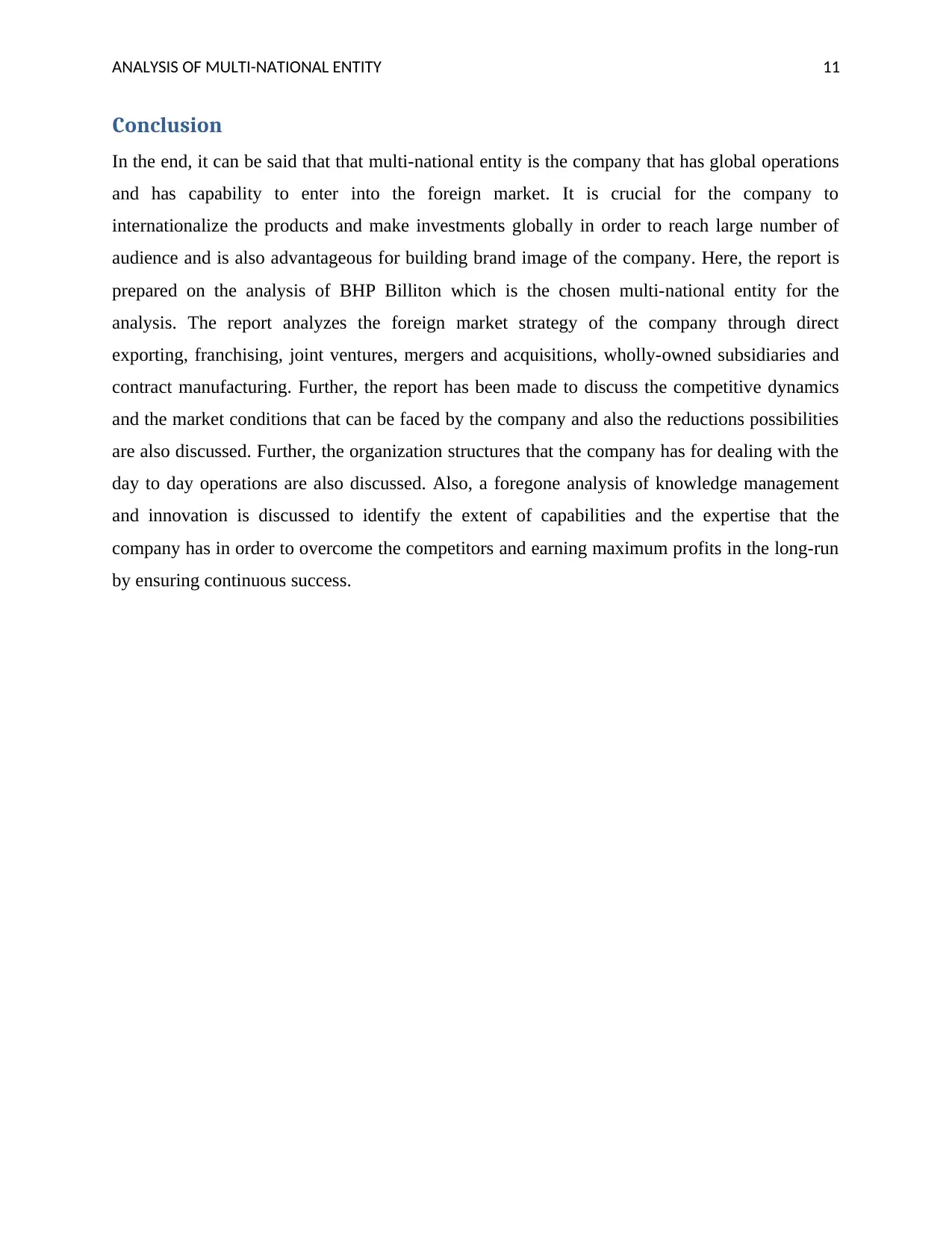
ANALYSIS OF MULTI-NATIONAL ENTITY 11
Conclusion
In the end, it can be said that that multi-national entity is the company that has global operations
and has capability to enter into the foreign market. It is crucial for the company to
internationalize the products and make investments globally in order to reach large number of
audience and is also advantageous for building brand image of the company. Here, the report is
prepared on the analysis of BHP Billiton which is the chosen multi-national entity for the
analysis. The report analyzes the foreign market strategy of the company through direct
exporting, franchising, joint ventures, mergers and acquisitions, wholly-owned subsidiaries and
contract manufacturing. Further, the report has been made to discuss the competitive dynamics
and the market conditions that can be faced by the company and also the reductions possibilities
are also discussed. Further, the organization structures that the company has for dealing with the
day to day operations are also discussed. Also, a foregone analysis of knowledge management
and innovation is discussed to identify the extent of capabilities and the expertise that the
company has in order to overcome the competitors and earning maximum profits in the long-run
by ensuring continuous success.
Conclusion
In the end, it can be said that that multi-national entity is the company that has global operations
and has capability to enter into the foreign market. It is crucial for the company to
internationalize the products and make investments globally in order to reach large number of
audience and is also advantageous for building brand image of the company. Here, the report is
prepared on the analysis of BHP Billiton which is the chosen multi-national entity for the
analysis. The report analyzes the foreign market strategy of the company through direct
exporting, franchising, joint ventures, mergers and acquisitions, wholly-owned subsidiaries and
contract manufacturing. Further, the report has been made to discuss the competitive dynamics
and the market conditions that can be faced by the company and also the reductions possibilities
are also discussed. Further, the organization structures that the company has for dealing with the
day to day operations are also discussed. Also, a foregone analysis of knowledge management
and innovation is discussed to identify the extent of capabilities and the expertise that the
company has in order to overcome the competitors and earning maximum profits in the long-run
by ensuring continuous success.
⊘ This is a preview!⊘
Do you want full access?
Subscribe today to unlock all pages.

Trusted by 1+ million students worldwide
1 out of 15